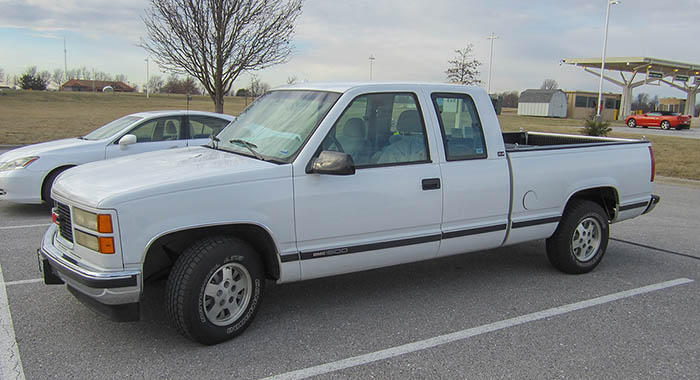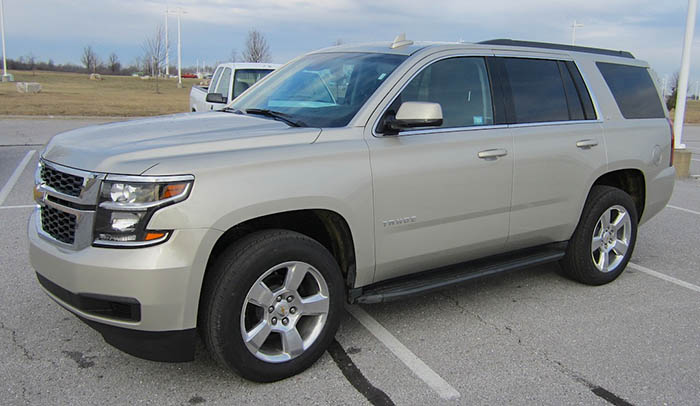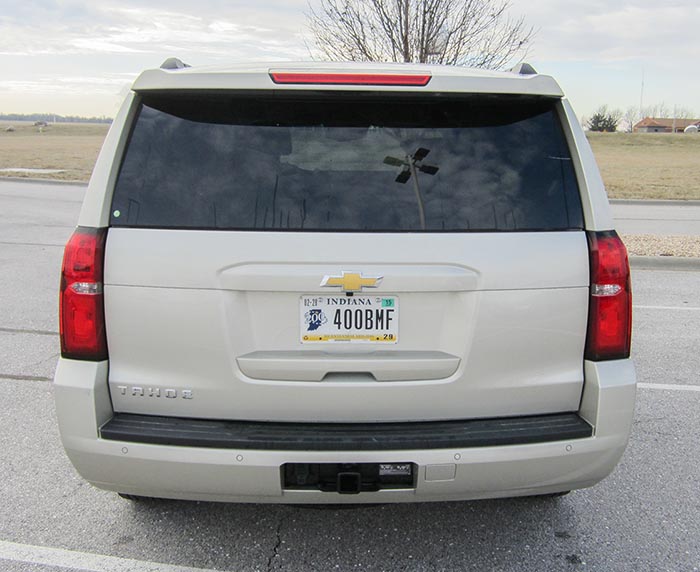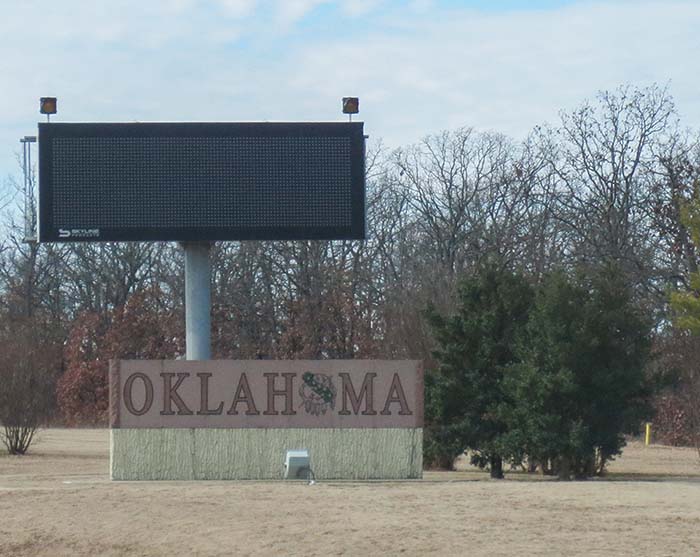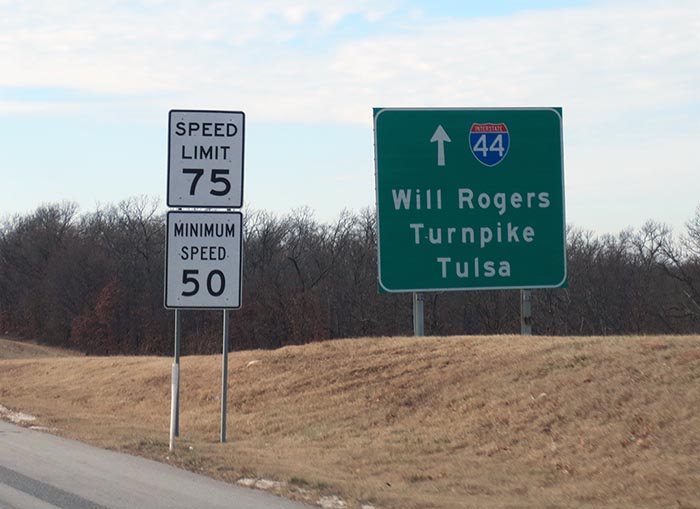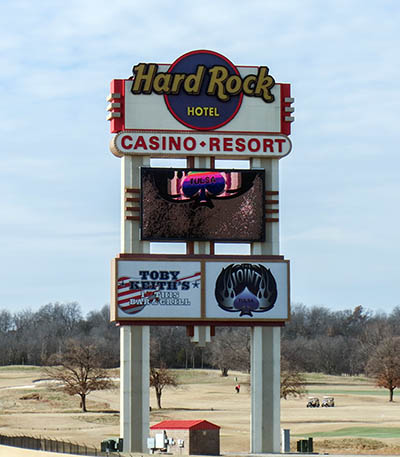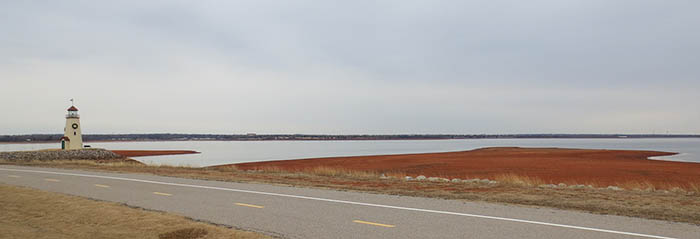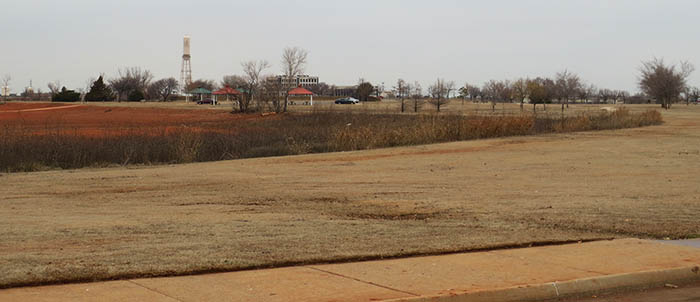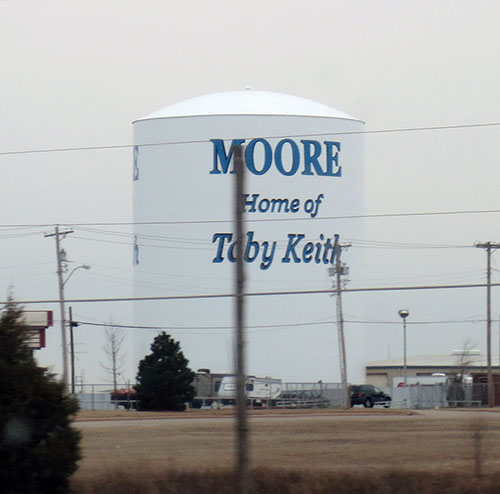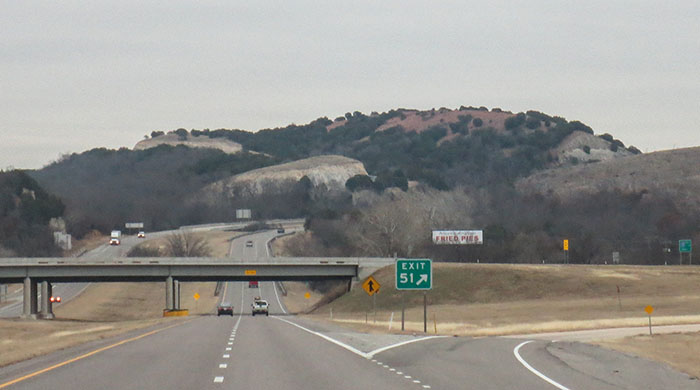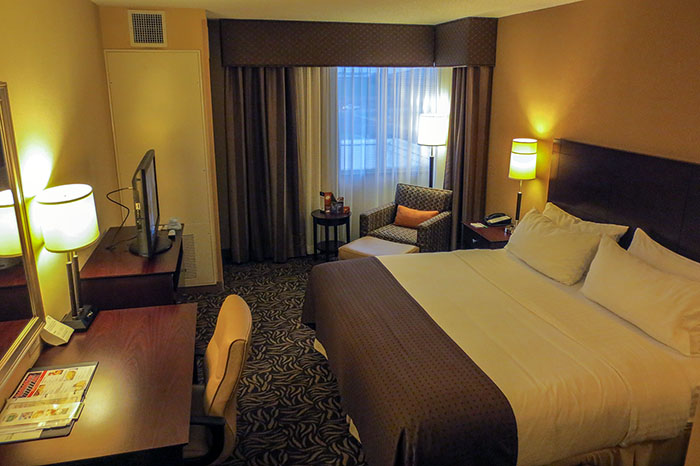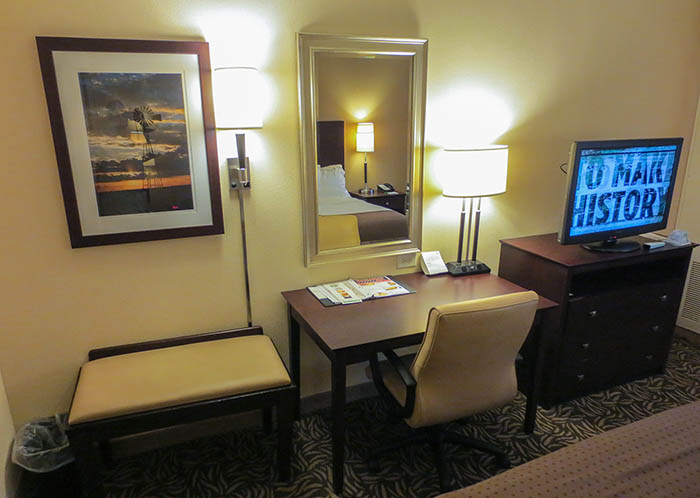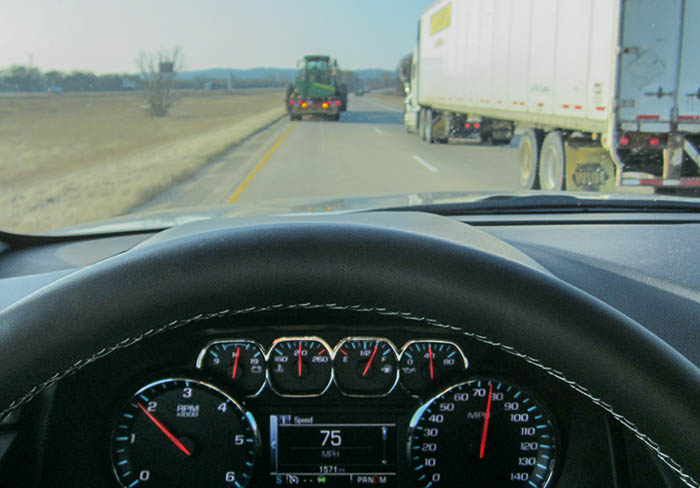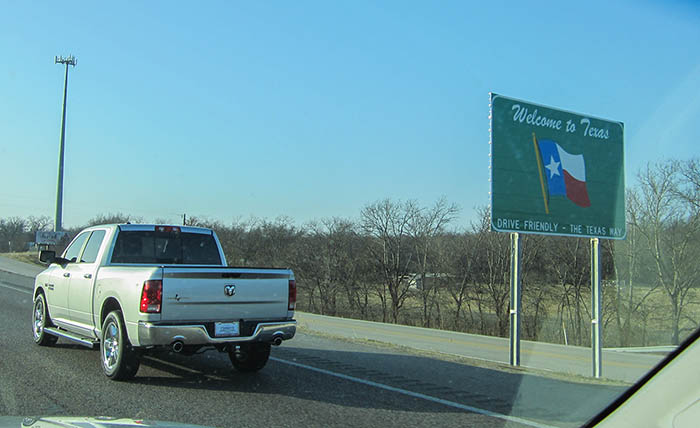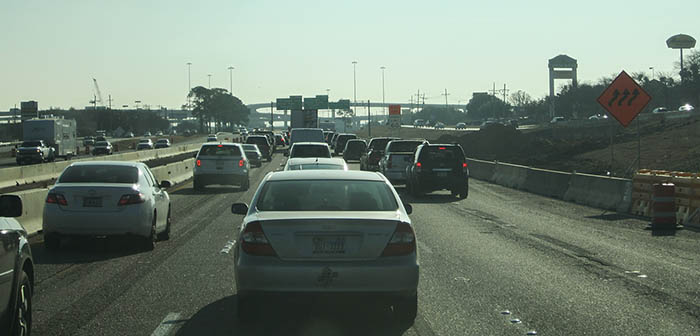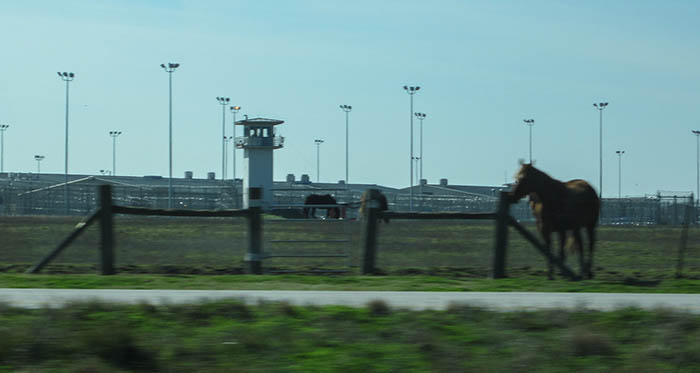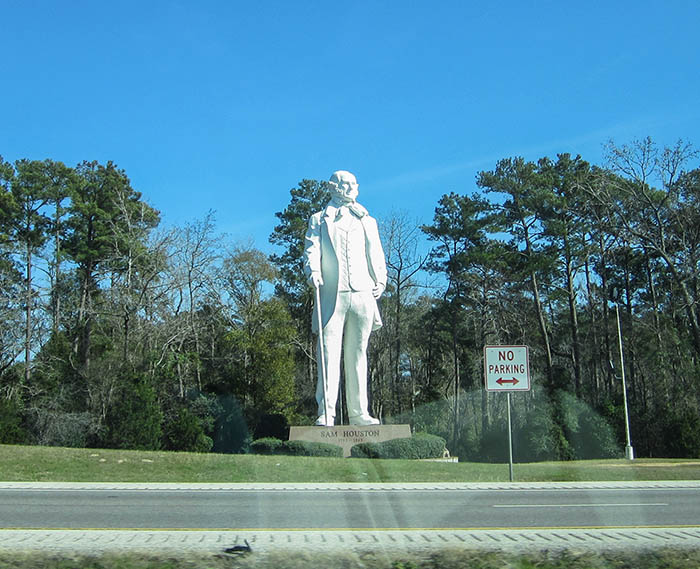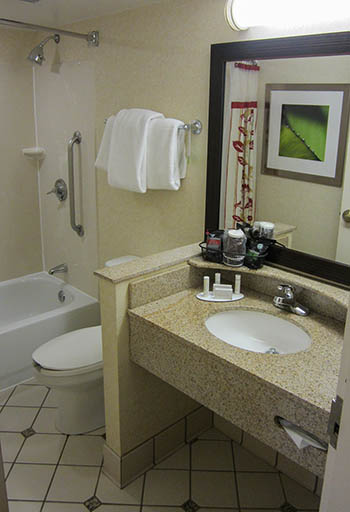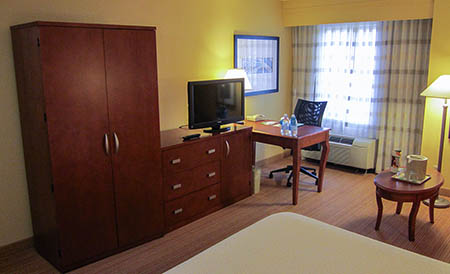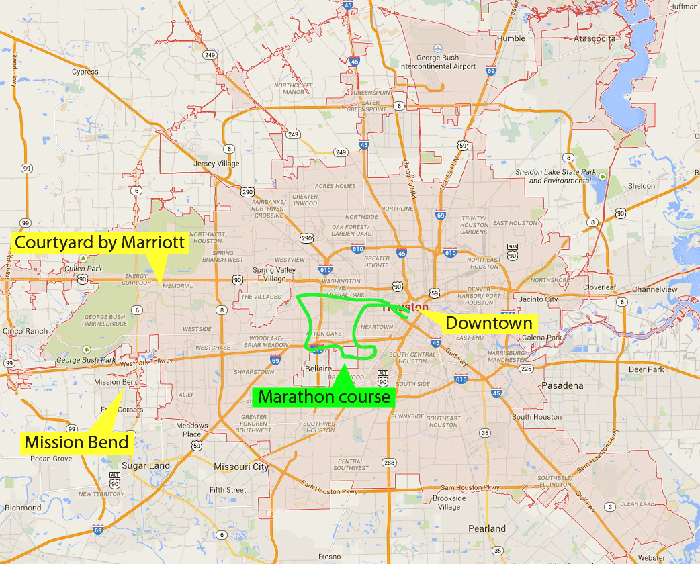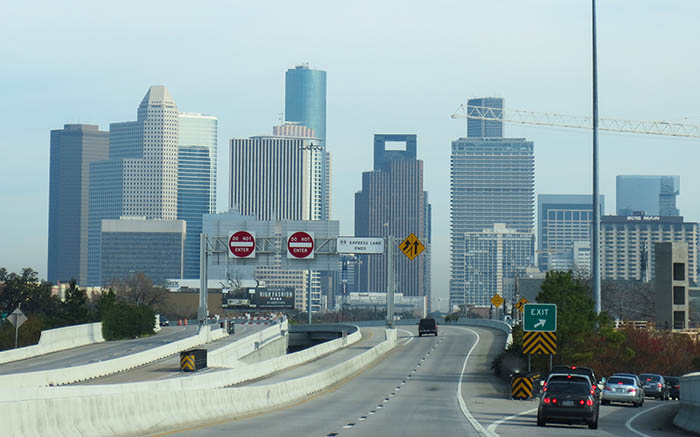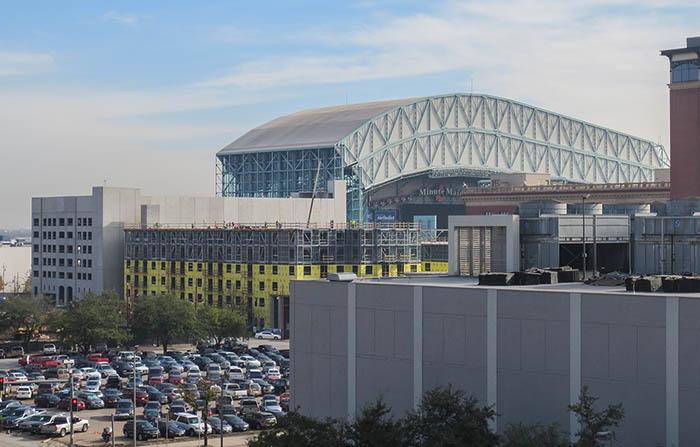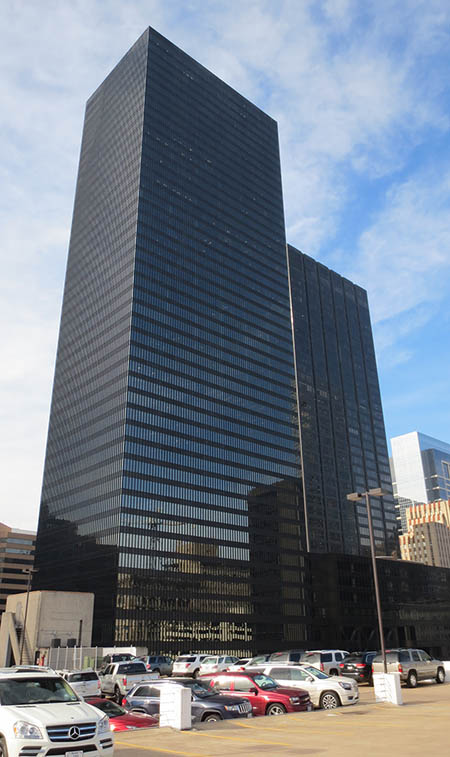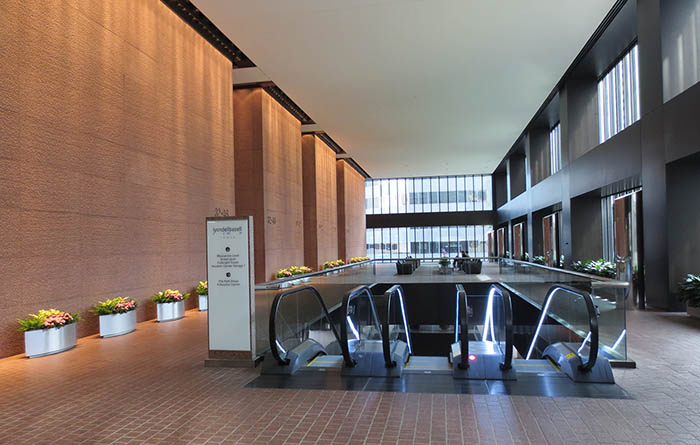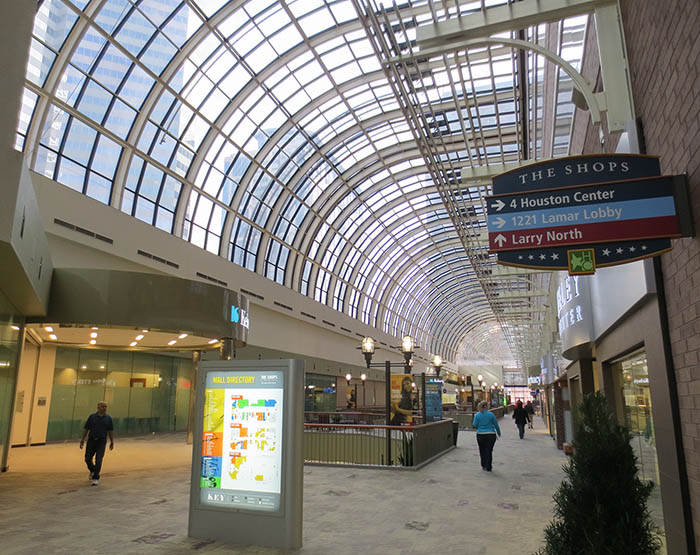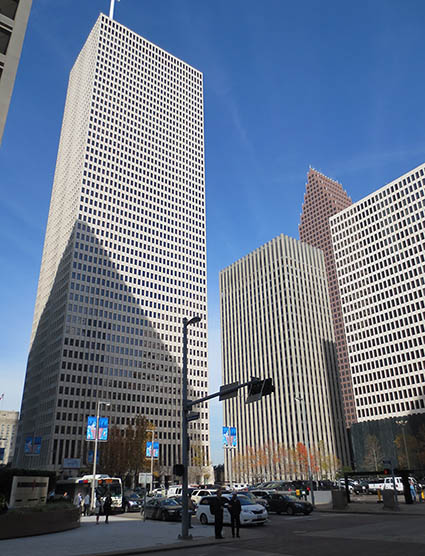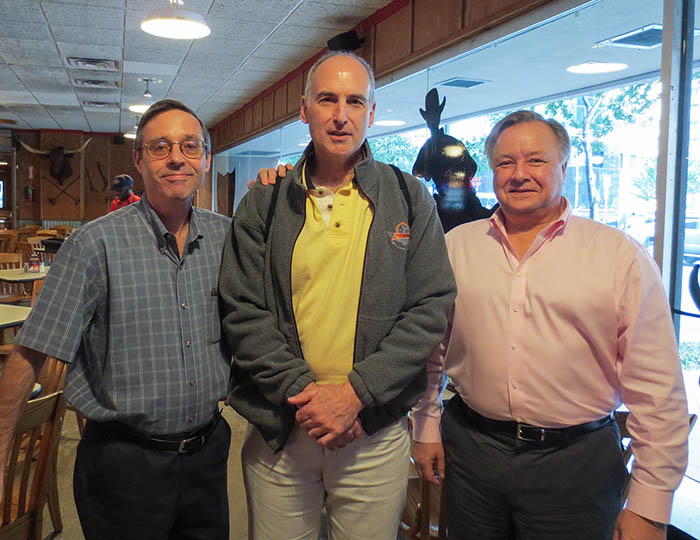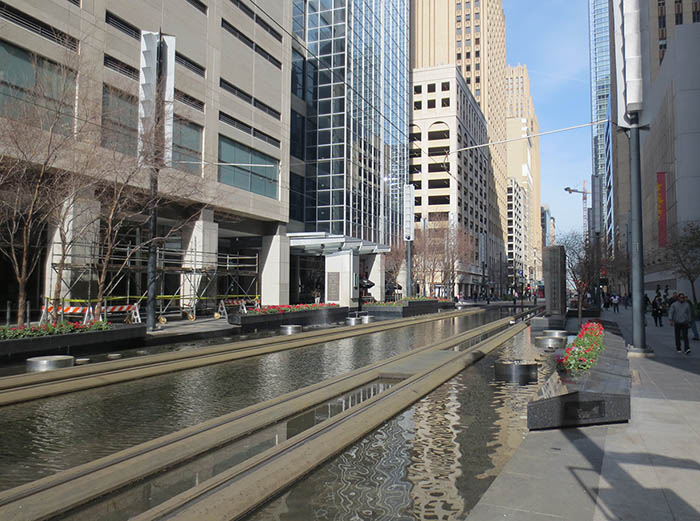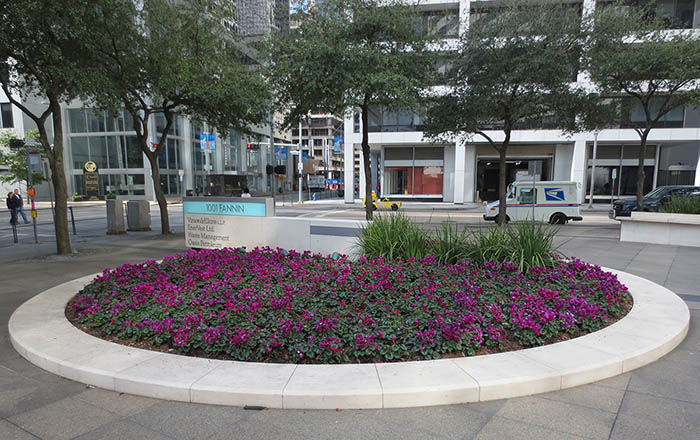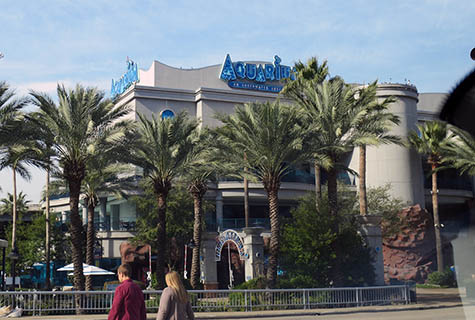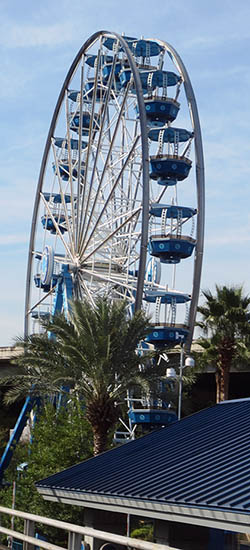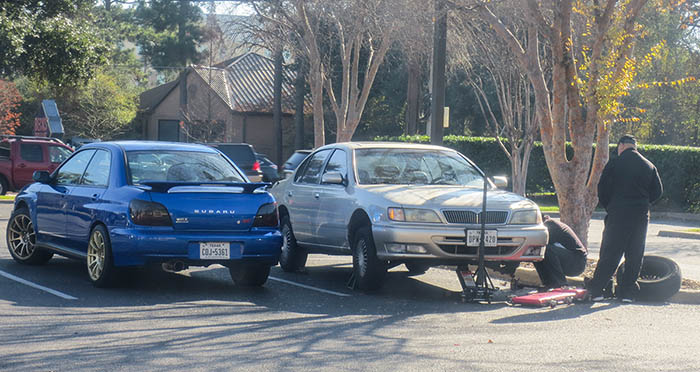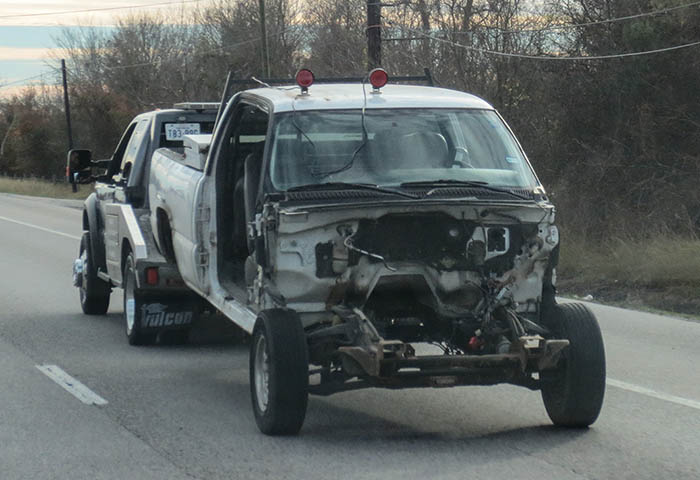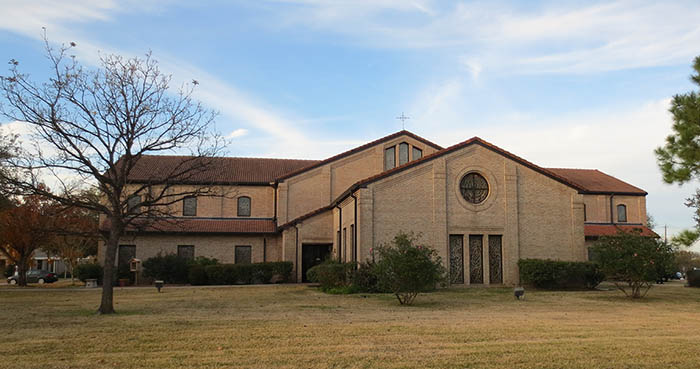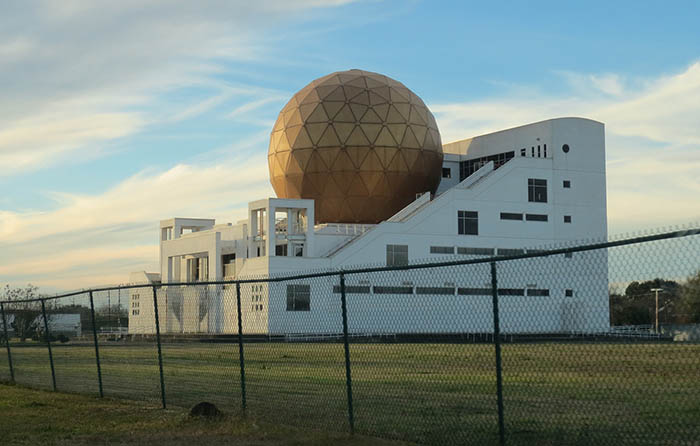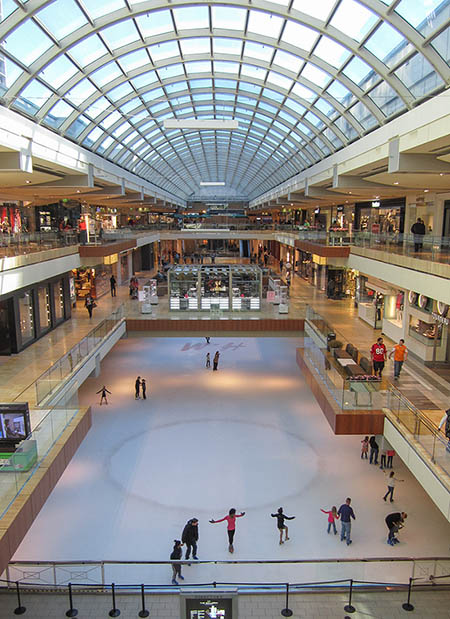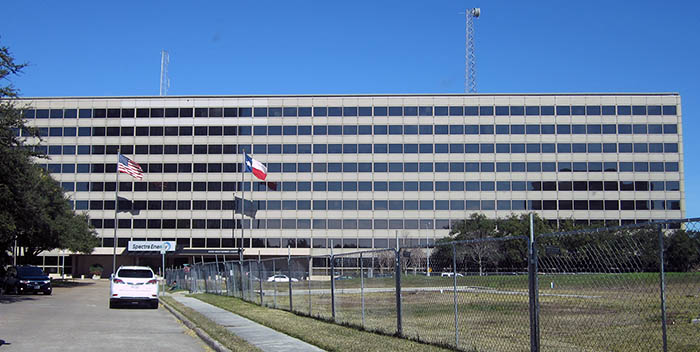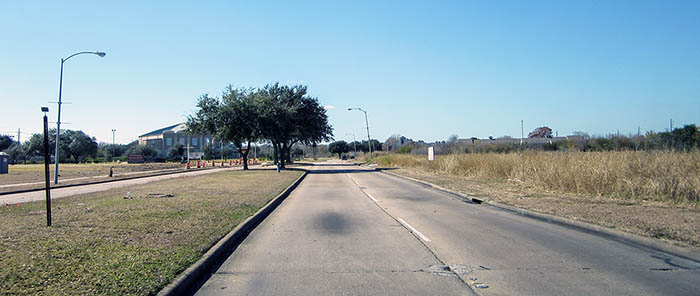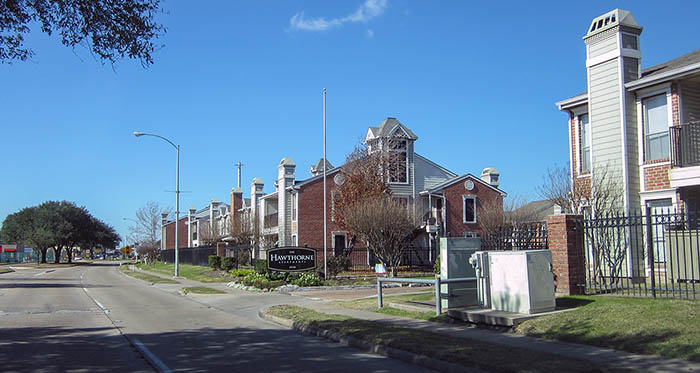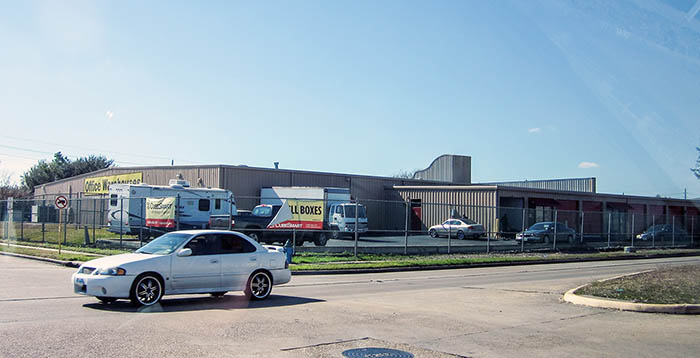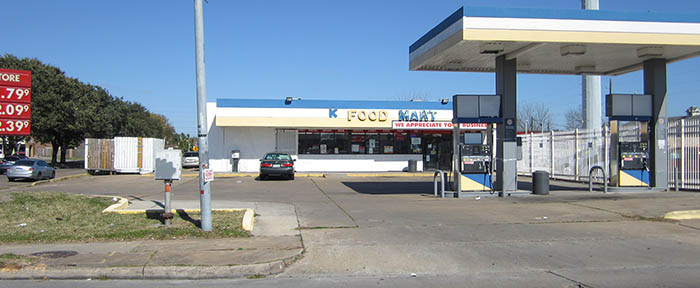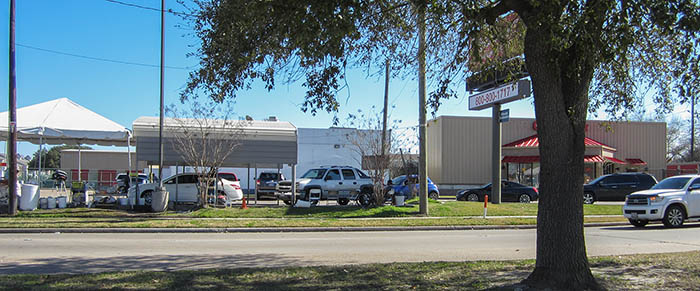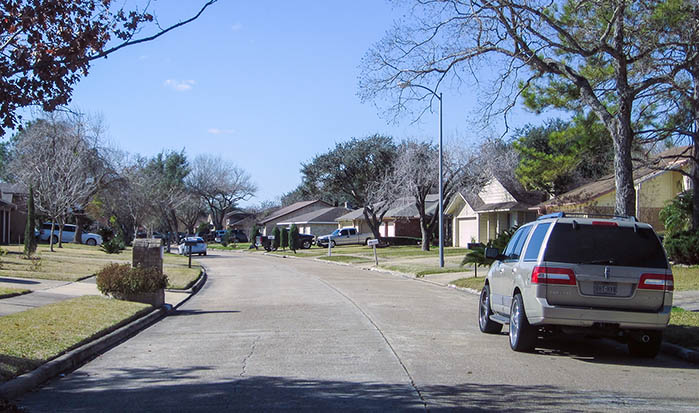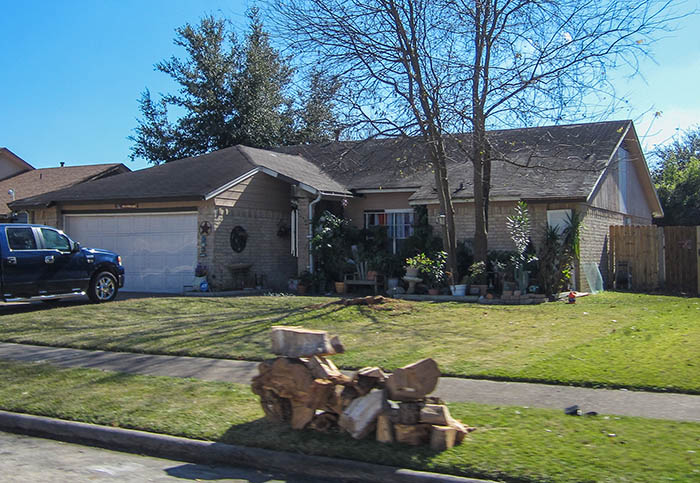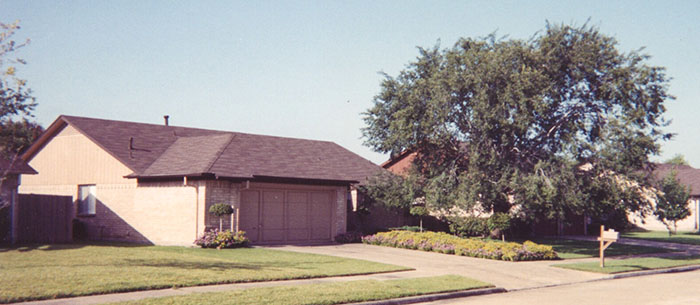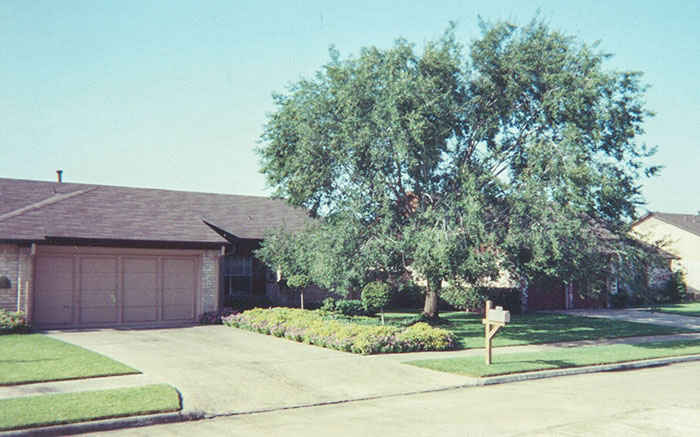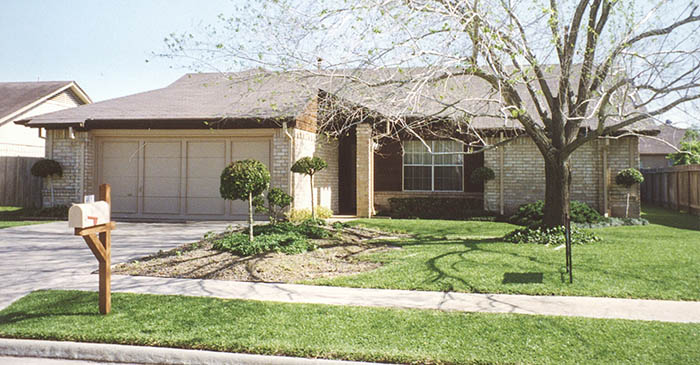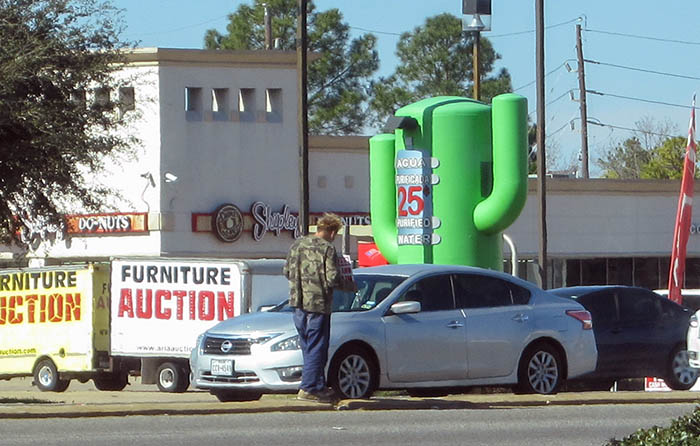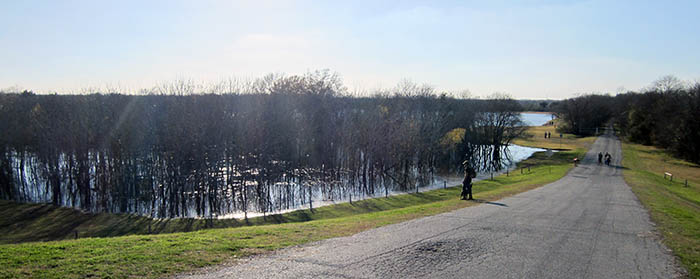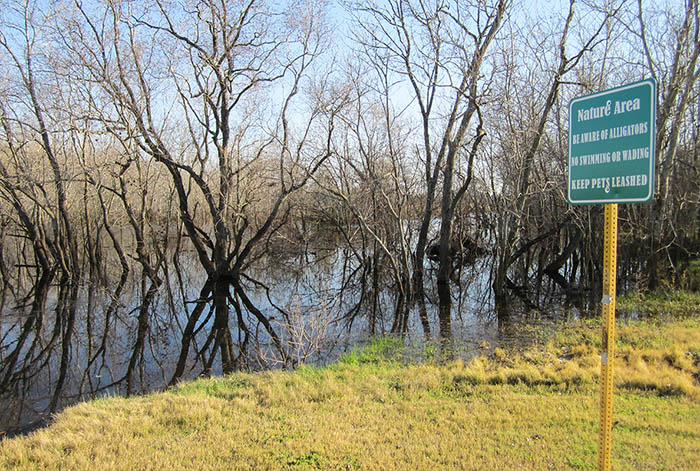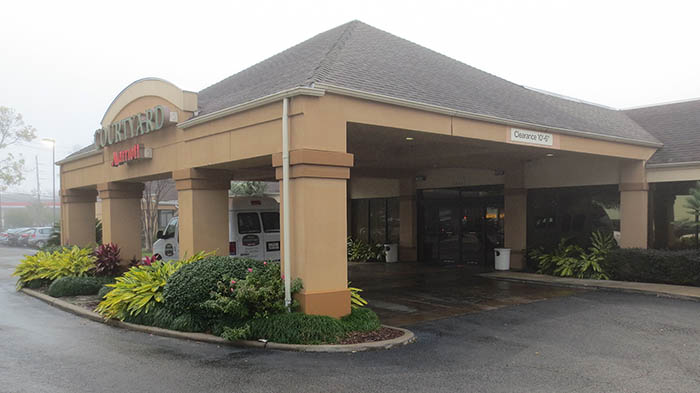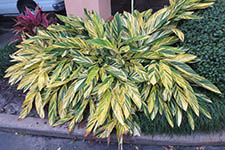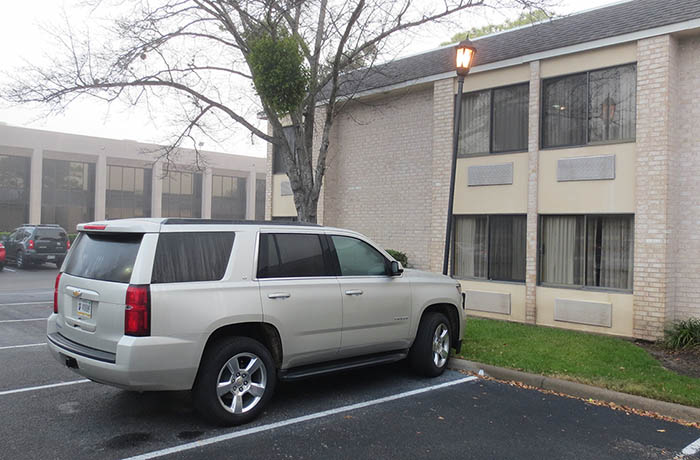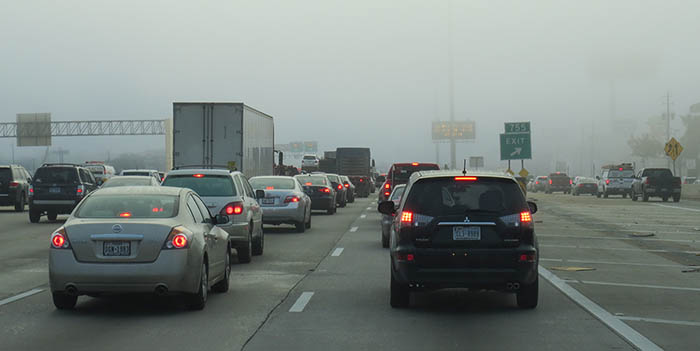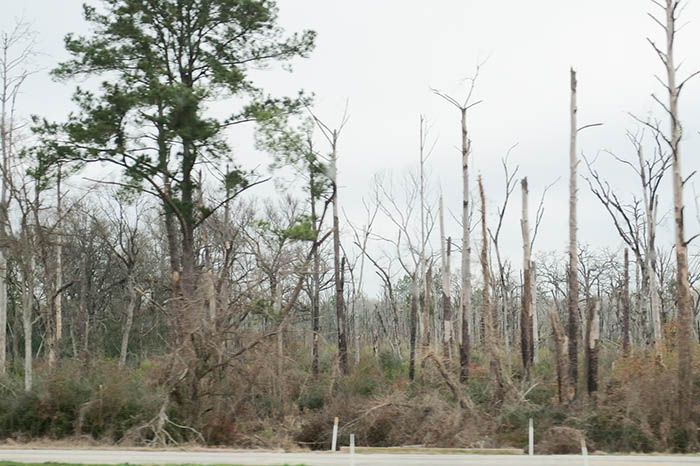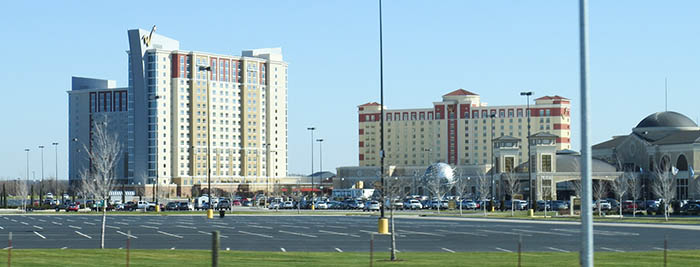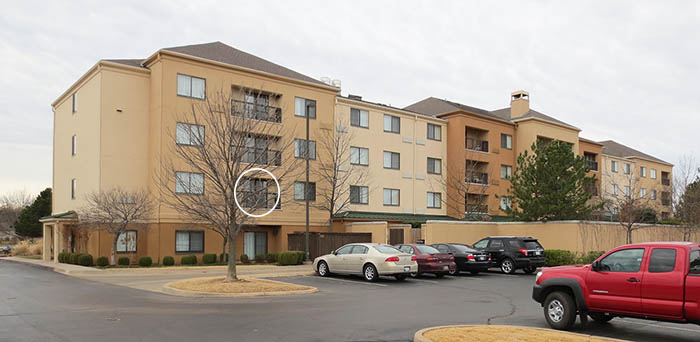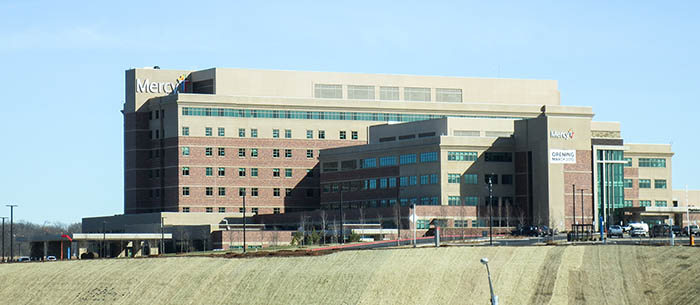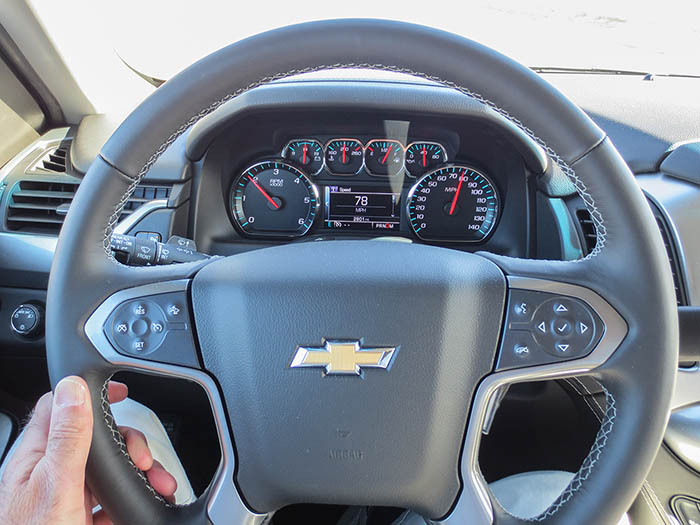
TRIP PHOTOS
These photos are from my trip to Houston from January 14 to January 18, 2015, to run in the Chevron Houston Marathon. A separate collection of photos from the race can be found here.
Click on any photo to view a larger image.
* * * * *
Wednesday, January 14th. I thought driving a 20 year-old truck on an 1800-mile trip would be too risky, so I drove to the Springfield airport and rented a car from Enterprise Rent-A-Car. The expense was well worth the peace of mind.
My rental car was a nearly new Chevy Tahoe with just 1120 miles. I reserved an intermediate SUV, and Enterprise offered this for an extra $10 per day. (I strongly suspect the people at the counter are trained to offer a more expensive rental if one's available.) I quickly agreed, and was glad I did. It was an outstanding vehicle, and was more comfortable and quieter than anything I've ever driven. There was only one downside to it--the owners manual had been removed from the glove compartment, so I had a number of incidents where I couldn't immediately find out how to operate things like the rear window wipers, tailgate, etc. I really felt like an idiot during my first stop for gas when I tried to open the hood to check the oil. I stopped in at a Chevy dealership just down the street from my hotel in Ardmore, Oklahoma, to ask. (I later downloaded a Tahoe owners manual off the Chevrolet website.)
Lots of Oklahomans and Texans were probably saying bad things about drivers from Indiana.
The Oklahoma/Missouri border on I-44, 75 miles from the Springfield airport. My plan was to drive to Oklahoma City (360 miles from the Lake) and see if I wanted to stay there, or try to make some additional progress.
The Tahoe cruised along nicely at 80 mph in Oklahoma. What made the 800-mile drive (each way) to Houston and back so much more enjoyable was listening to episodes of the Jack Benny radio show stored on my iPod and played through the car's stereo system. Each episode was about 28 minutes long, and I listened to nearly 50 episodes, all recorded between 1950 and 1953. They were hilarious!
About 30 miles into Oklahoma is an interesting fuel and rest stop that includes a McDonald's restaurant overlooking the Will Rogers Turnpike. It was closed for remodeling when I passed by on my way to and from Oklahoma City in September. It looks much nicer now, at least on the outside. (Time was short, so I didn't go inside.)
The Hard Rock Hotel & Casino is on the far eastern edge of Tulsa, and is one of the very first landmarks you see coming into the city. That, and the Walmart supercenter right next to it.
When I reached Oklahoma City, I took a detour to the west side of the city to see Lake Hefner. I've spent many, many hours there during six Redman Triathlons. I've never seen it other than in the month of September. The lake level is low at this time of year, exposing some of it clay bottom.
The start/finish area for Redman is near the trees and pavilions in the center of the above photo. It was cold when this photo was taken, so the park was deserted.
Just south of Oklahoma City is the city of Moore, which was hit in May 2013 by a powerful tornado that killed 24 people and injured nearly 400. (See my 2014 Redman race report for photos taken during a drive around Moore.) Toby Keith is a very successful country music singer-songwriter who's extremely popular in his home state of Oklahoma. Bar and grills bearing his name (he merely licenses his name; he doesn't own the restaurants) are located all across the country. One is located in the Hard Rock Hotel & Casino in Tulsa, as the sign a few photos earlier shows.
You know you're not in Missouri when you see an oil field "rocking horse".
This hill--a virtual "mountain" by Oklahoma standards--came as a complete surprise, as I've never seen hills and rock bluffs like this anywhere else in Oklahoma. I'm not certain what the area is called, but just to the west of it is Turner Falls Park and the city of Davis. This is about 70 miles south of Oklahoma City.
I stopped for the night in Ardmore, Oklahoma and stayed at the Holiday Inn. It was a very nice hotel attached to a convention center, and the parts of the city located near Interstate 35 looked just as nice and new. I had traveled 420 miles so far, and was now a little more than halfway to Houston.
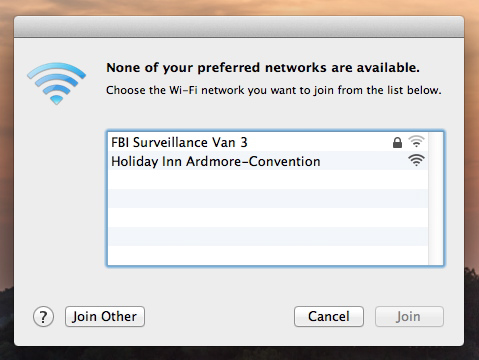
I think someone near the hotel was playing games with the name of their wireless router.
* * * * *
The speed limit was 70 on this stretch of I-35 between Ardmore and the Oklahoma/Texas border, but the truck driver hauling a wide farm tractor ahead of me was in a hurry to get where he was going. I stayed behind him for miles. The distances between the big cities in this part of the country are so long, and the scenery usually so boring, that you're tempted to drive over the speed limit.
How coincidental that I snap a photo of the Texas welcome sign with a brand-new pickup truck in view. Texas is the pickup truck capital of the world. The "Drive Friendly - The Texas Way" tagline on the sign falls on deaf ears. Driving outside Dallas and Houston isn't bad, but driving inside those cities is wild. I've never seen so much lane changing when there was so little space between cars. Leave more than a car's length between your car and the one ahead of you, and someone will pull into it. They'll even come up from behind you and pass on the right to claim that space. It's shocking. Yet, I came upon very few fender-benders.
My welcome to the northern part of Dallas. I-35 is undergoing major reconstruction, and the traffic was awful. The bumper-to-bumper, stop-and-go traffic went on for miles.
Billions of dollars must have been spent in expanding existing roads and building new ones in Houston since I left 22 years ago, and it looks to be true in Dallas as well. Road construction in this state never ends. You'd think it would ease congestion, but with a constant influx of new residents, these cities are as traffic-choked as ever.Seventy miles north of Houston is the city of Huntsville, which is known primarily for being the home of two state prisons. The one housing the worst of the prisoners, and home to the state's execution chamber, is located in downtown Huntsville. The other one, pictured above, is located along Interstate 45, and houses about 2,000 prisoners. It sits on 1,400 acres, and is surrounded by a farm and ranch. Some Texas state prisons operate farms. This may be one of them.
A couple miles south of Huntsville, right along I-45, is a 35-40 foot statue of Sam Houston, the Virginia-born politician and soldier who won independence for Texas from Mexico in 1836 by defeating Mexican president and general Santa Anna's army in the Battle of San Jacinto near what is now known as the city of Houston. He became Texas' first president, and later a U.S. Senator after Texas was annexed into the United States in 1845.
Texas is pretty serious about making sure it collects tolls from vehicles using its tollways. These cameras were at a toll booth on the Beltway 8 toll road inside Houston's city limits. I paid $1.75 at each of two toll booths while on the tollway, and it was worth it because it saved me from having to drive through lots of traffic near the center of the city.
While in Houston, I stayed at the Courtyard by Marriott along Interstate 10 in the Energy Corridor, near Dairy Ashford Rd. The bathroom is a bit different, but the rest of the room is very similar to that at the Courtyard in Oklahoma City. The bed, couch, table, desk, lighting, wallpaper and carpeting are the same, or nearly so. The photos/artwork on the walls are exactly the same. I wanted to stay at a hotel not too far from where I had lived years ago so that I could drive around and see areas that I was once familiar with.
A map guide to my stay in Houston. Mission Bend is where my house was located. You can see by the 26.2-mile length of the marathon course (in green) that Mission Bend was about a marathon away from where I worked in downtown Houston.
* * * * *
What kind of hotel am I staying at? The morning after I arrive, I drive through the hotel's parking lot to head downtown, and see a Cadillac Escalade sitting up on cinder blocks. This hotel is located in a nice part of town, with lots of traffic passing by, and rooms not far away. I don't know what was going on with this car, but it's hard to believe the car's wheels were stolen.
I'm heading north into downtown Houston after exiting the Southwest Freeway. I rode the bus to and from work for years, and this was the route that the bus used. I was planning to use this route on Sunday (race) morning, so I wanted to test it out first.
Minute Maid Park, seen here from the top of a parking garage, is the home of the Houston Astros baseball team. When I lived in Houston, the Astros played at the Astrodome. (It's still standing, but they're still trying to figure out whether to demolish or redevelop it.) Minute Maid Park has a retractable roof.
The 46-story 1 Houston Center (now known as LyondellBasell Tower) at left, and the shorter 2 Houston Center at right. I worked on the 38th floor, and then 45th floor, in 1 Houston Center from 1981 to 1990. The company I worked for, Texas Eastern Corporation, owned the Houston Center development, which included these and other buildings nearby, along with many blocks of undeveloped land (at the time) that extended all the way east to the George R. Brown Convention Center. The land for the convention center was donated to the city by Texas Eastern (with the hopes it would spur development on properties the company owned). George Brown was a co-founder of Texas Eastern.
The pink granite interior of 1 Houston Center lobby hadn't changed a bit. The reception area is in the background.
The Shops at Houston Center is a two-story shopping center in the lower floors of 4 Houston Center office building, and is connected by skywalks to other office buildings and the Four Seasons Hotel. Texas Eastern built the shopping center and 4 Houston Center. The shopping center looks like it's doing well. Not long after it opened in the early 1980s, though, things weren't going well, and shops started leaving. One of the projects I worked on in the late 1980s for the company was to look at the possible sale of all of our Houston Center development. It didn't happen until after Panhandle Eastern bought Texas Eastern in 1990 and then proceeded to sell everything except Texas Eastern's gas pipeline operations.
A street level view of The Shops at Houston Center (right), 4 Houston Center (middle), and the Four Seasons Hotel (left).
2 Houston Center (left), 1 Houston Center (middle) and the Fullbright & Jaworski Tower (formerly the Gulf Tower). The red arrow points to the office I occupied for the last few years I worked for Texas Eastern. I had a great view to the south. Major office buildings may change names, tenants, and owners, but their looks never change.
One of the biggest surprises to me in downtown Houston was seeing One Park Place, a 37-story apartment building located across the street from The Shops at Houston Center. It was completed in 2009. I would never have thought that anyone would want to live in downtown Houston. But then, that was before Minute Maid Park, the Toyota Center (home of the Houston Rockets basketball team) and a number of restaurants and stores were built nearby. Plus, with Houston's horribly congested highways, living downtown can save you hours of commuting each day. The rents start at $2,700 for an 800 square foot unit.
My first job after graduating from business school in 1978 was a financial analyst position with Houston Lighting & Power, the electric utility serving Houston and surrounding areas. I spent much of my time there working on projects for Primary Fuels, Inc., a small oil and gas exploration subsidiary of HL&P's parent company, Houston Industries. The Houston Industries/HL&P headquarters was the building in the center of the photo, adjacent to the 50-story One Shell Plaza building on the left, and Two Shell Plaza on the right. The building was sold to the City of Houston years later. Houston Industries and HL&P went through major corporate changes, and had some very rocky years as a result of some bad business decisions.
The highlight of my entire trip--even more than finishing the marathon--was having lunch with two former co-workers at HL&P whom I hadn't seen in about thirty years. Chris Picard (left) and Dan Werring (right) are still working for HL&P, which is now known as CenterPoint Energy. They, too, were financial analysts when they started working for the company about a year after I did.
When I received my lottery entry to the marathon last June, I was hoping to see them during my trip, but I held off attempting to contact them since I didn't know if I would be able to make the trip (for weather or other reasons). Also, while I had corporate e-mail addresses for Dan and another former co-worker (Marc Kilbride), I hadn't traded e-mails with them for about six years, so I didn't know if they even worked for the company anymore. (Marc had moved up the ranks and was the corporate treasurer, but he retired last year with health issues.)
On the night before having to go downtown and pick up my marathon race packet, I took a chance and sent e-mails to Dan and Marc. To my pleasant surprise, Dan responded and asked me to give him a call. (When I called, his voice sounded exactly like it did thirty years ago.) So, before heading downtown, I called him, and we arranged to meet at noon in the company's lobby. We headed over to Pappa's BBQ--a favorite lunch spot of mine years ago. It was known back then as Luther's BBQ, but it hadn't changed a bit.
We had a great time reminiscing about the old days at HL&P, and catching up with what we (and people we remember) have been doing since then.
I'm hoping to see Dan and Chris in a few years when I go back to run the Chevron Houston Marathon again.
Main Street in downtown Houston has undergone a dramatic change. Years ago, it looked like any other downtown street, with lots of traffic and buses picking up and dropping off passengers. It also had its share of panhandlers and loiterers. There were some retail shops on Main Street, including Woolworth's and a Foley's department store (whose name in Houston has been changed to Macy's) that have since closed. The most dramatic change, though, is the replacement of buses (and vehicle traffic) with a light rail system running down the middle of the street. They've also made it look attractive. In the photo above, the tracks pass through a decorative water basin.
Nice landscaping is often seen around some of the nicer office towers. This one is in front of the First City Tower. Besides First City National Bank, a major tenant is the law firm of Vinson & Elkins. V&E was Texas Eastern's outside counsel, and I worked with quite a few of their attorneys (including Alberto Gonzalez, who went on to become attorney general in the George W. Bush Administration) on various corporate deals.
Downtown Houston has far more attractions now than years ago. In addition to the baseball park, basketball arena and performing arts centers, the Aquarium (pictured above) was built just on the edge of downtown. It's an amusement park featuring not only an aquarium, but also amusement rides, exotic animals, etc.
* * * * *
I looked out my window at the Courtyard by Mariott on Saturday morning and saw a police car in the nearly deserted lot. (This is mostly a business hotel, so things slowed down dramatically on the weekend.) I'm not sure, but I think the hotel may serve free breakfast to police officers. This officer must have been in a hurry--he didn't do a very good job of staying between the lines.
Later on Saturday morning, I looked out and saw someone replacing the wheel of a car. The owner of the car is at right. The guy changing it showed up later in the blue Subaru. I don't recall seeing so many strange things in the parking lot of a hotel I've stayed at.
I saw all sorts of head-turning stuff in Houston. This photo was taken while on Highway 6, on the west side of Houston. The tow truck had just pulled out of an auto repair shop a few miles north of where I lived. I can't imagine what this truck would be good for, unless it was headed to the salvage yard.
A street corner window washer is something I haven't seen since leaving Houston. This photo was taken on a Saturday afternoon at a stoplight. (The motorist allowed him to wash the windshield.)
St. Justin Martyr Catholic Church. The west side of Houston was growing quickly when I bought my house in 1981. (Growth stopped a couple years later when oil prices tanked, and things still hadn't recovered by the time I moved back to Missouri in 1993.) The parish was formed soon after I bought my house, and masses were held at another church until we could build our own. The new church was nice, and we had a good group of parishioners. The first pastor was a good, young guy, but he had an emotional breakdown in the late 1980s, perhaps due to all the stresses that pastors face. He left to get treated, and a few years later became pastor of another parish south of ours.
This building took me by surprise, as it was situated on what used to be part of the church's parking lot. My guess is that it's used for the parish office, meetings, religious education, etc.
Not far from St. Justin Martyr was this strange looking building that I had to stop to take a photo of. There were no signs indicating what it was, but according to Google maps it's the Chong Hua Sheng Mu Holy Palace. I assume it's a Chinese temple, although when viewed up close it looks like it was shuttered some years ago.
* * * * *
I needed to do some walking the day after the marathon, so I first headed to the Houston Galleria. It's a high-end shopping center that attracts lots of tourists. The skating rink has been part of the Galleria since it was first built.
This is the corporate headquarters of Spectra Energy, a natural gas pipeline company. It was originally an office for Bechtel, a big engineering company. Without getting into a long history of corporate transactions, Spectra owns Panhandle Eastern Corporation, the company that bought Texas Eastern in 1990. I worked on a few, short projects for Panhandle Eastern on a consulting basis, mostly as a favor for a few former Texas Eastern executives who asked for some help. I worked in this building for one of those projects, and pretty much hated the building (an ugly cubicle farm on the inside) and the assignment. The money was pretty good, though.
This came as a surprise. The photo was taken on Bellaire Blvd., about a mile away from where I lived in the Mission Bend area of west Houston. After seeing so much new development elsewhere in Houston on this trip, I was expecting to see lots of development here, too. Instead, I saw that most of the commercial properties along Bellaire that were vacant twenty-two years ago were still that way. Back then, the west side of town had lots of empty strip malls that were built just as the Houston economy went bust. (At the worst of the downturn, 20% of the homes on my street were either vacant or for sale.) I figured that, with Houston's growth since then, those malls would be completely leased, with new malls and businesses added to the area. That obviously wasn't the case. (I did, however, see many homes that had been built since 1993.) After barely recognizing so much of what I had seen of Houston these past few days due to all of the new development, Mission Bend was the one area that I recognized very easily because it hadn't changed much at all.
These apartments along Bellaire Blvd. can be seen in the distance in the previous photo. They were built when I was living in Mission Bend. They look like they've been kept up well.
A really ugly mini-warehouse was built on Bellaire Blvd., right across the street from the apartments. These were built after I left, thankfully.
This was disappointing to see, as it was the first indication that Mission Bend wasn't as nice as it once was. For about seven years, I rode the bus to and from work, and the bus stop was located in front of this convenience store (it was a Circle K back then) at the intersection of Bellaire Blvd. and Addicks Clodine Rd. (It was about three blocks away from my house.) The store now looks like a run-down business in a bad part of town.
Across Addicks Clodine from the convenience store was this car wash (which I don't remember) and a tire shop (which had been a small hardware store). The more I saw of the area, the worse it looked. In the early 1990s, gang activity was increasing in the Mission Bend area. (Some thug had even tried to kick in my front door.) I was starting to get the impression that things had gone far downhill, and that this was no longer a nice part of town.
Right across Bellaire Blvd. from the convenience store was another convenience store (at left) that was built after 1993. When I drove by and saw some Hispanic guys washing cars by hand under the tent and carport (you can see the line of cars waiting for a wash), it looked like something you'd see in the inner city, not in a nice residential area.
A couple blocks later, I turned onto Pasadero Drive. I lived on this street, five houses from the far end. As I was heading down the street, I thought it looked good. It gave me a much better impression than the commercial businesses I had just seen. The houses looked like they were maintained well. None of the trees in this photo were there when these houses were built around 1980 to 1982.
This is my old house, at 16107 Pasadero Drive. Sadly, the house that was once the most meticulously maintained house on the street was now among the worst. Granted, this photo was taken on a Monday, two days after they had a garage sale on Saturday, so the junk on the street isn't indicative (I hope) of how the home is normally kept. (I drove by on Saturday to take a photo, but the presumed homeowner was out in front of the house--complete with a big "Blowout Sale" banner hanging from the gutter--and I wasn't able to snap a photo since he saw me driving by). Frankly, while others might think it looks fine, I was horrified by the way the place looked, especially compared to what it once did. I felt bad for my former next-door neighbors, Tony and Kathy Ciccone, who still live in the house at right. My only consolation is knowing that the current owners are not the ones to whom I sold the house.
I bought the house for $74,000 in 1981, and sold it for $64,000 in 1993.
The house needs work (fresh paint, gutter repairs, etc.), and all the pots and stuff in the front of the house really detracts from its appearance. It appears that my big elm tree in the front yard had just been cut down.
The above photo, plus the two that follow, were probably taken in the summer of 1993, soon after I sold the house and moved away in mid August.
I planted this raised bed with melampodiums (in yellow) and periwinkles (in purple). The elm tree grew very quickly (it was a small tree when planted by the builder in 1981), but it wasn't durable--I lost lots of branches in storms over the twelve years I lived there. (That's why you can see through its middle section in the two prior photos.)
The above photo was taken early in the spring in 1993. Look closely and you'll see the shadow from the for-sale sign in front of the elm tree.
You very rarely see panhandlers in Missouri. The only ones I recall have been at the Interstate 70 exit ramp in Kingdom City. I saw a bunch of them in Houston, and Oklahoma City as well. The one pictured here was at the intersection of Highway 6 and Bellaire Blvd., which could be considered the entrance to Mission Bend. Years ago, this intersection had a number of nice stores and restaurants nearby. Those businesses are mostly gone, replaced by businesses serving a less well-off clientele.
A couple miles north of Mission Bend, along Highway 6, is George Bush Park. The City of Houston basically took a huge flood control reservoir (it still serves as one) and created a nice park out of it, with miles of walking and biking paths. It would have been a great place for me to train had it been built years ago.
This sign near the swampy area in the previous photo says, "Be aware of alligators." Alligators had apparently moved to Houston while I was away. A fellow nearby said he had seen them in this swamp. A six-footer was caught a few miles away in Buffalo Bayou, which is where water stored in the reservoir is released. (Buffalo Bayou runs past downtown Houston and empties into Galveston Bay and, ultimately, the Gulf of Mexico.)
* * * * *
The Courtyard by Marriott, photographed on the foggy morning I left Houston. My only complaint--and it was a significant one--was the highway noise from Interstate 10 and the nearby access roads. (I-10 is located about 200 feet from the front of the hotel.) My room was on the side of the building, and the single-pane glass and window drapes allowed far too much noise into the room. The first night I was there, I was frequently awakened by it, and only less so the next four nights. It was, without doubt, the noisiest hotel room I've ever stayed in. I didn't complain during my stay, but mentioned it in my post-stay online survey. To make amends (for that, and the mold in the ice machine, which they said was professionally cleaned two months earlier), they gave me 2000 points (worth about 20 bucks) on my Marriott Rewards Card account. Unless they have much quieter rooms available, I won't be back to this hotel. Unfortunately, nearly all of the hotels in Houston are located along major freeways.
I wish many of the colorful and exotic plants that can be found all around Houston could survive our Missouri winters, but sadly they can't.
My room was on the first floor, directly ahead (and slightly to the left) of the Tahoe. I liked being able to use the door on the back of the hotel to quickly come and go. (By the way, I wasn't the one who hit the light pole, causing it to lean.)
After putting up with heavy traffic for five days, it only seemed fitting that I faced lots of it trying to leave Houston. This was stop-and-go, bumper-to-bumper, morning rush hour traffic on I-10 heading east. I'd go nuts if I had to face this every day.
About 30 miles north of Houston, I noticed large numbers of dead trees for miles on end. I assumed that bark beetles were responsible, as they've been a huge problem in Texas and elsewhere in the southern U.S. for decades.
Heading into Dallas, with still more traffic and road construction.
There are no casinos in Texas, but Texans need only venture one mile into Oklahoma to find the big WinStar World Hotel & Casino. Indian tribes own many, if not all, of Oklahoma's casinos. The Chickasaw Nation owns the WinStar.
After driving about 400 miles from Houston, I stopped in Oklahoma City for the night and stayed in my seemingly home away from home--room 234 at the Courtyard by Marriott in Oklahoma City. I stayed in this room last September while in OKC for the Redman Triathlon, and made my reservation for it this coming September. With the stairs nearby, I can get in and out of the hotel very quickly.
* * * * *
Mercy Hospital in Joplin took a direct hit from the tornado that devastated a large swath of the city in 2011. That hospital sustained serious structural damage, and had to be closed. Its brand-new replacement along I-44 will open this coming June.
Going from driving an almost new Tahoe to a 20 year-old pickup truck on the way home was like the difference between sleeping on a comfortable mattress versus a hardwood floor. This was a fantastic vehicle. If I didn't have a need for a pickup truck, chances are this is what I would buy.
I put about 1800 miles on the Tahoe, leaving it with 2900 on the odometer.
I learned a strange thing about car rentals--or at least the way Enterprise does it. If I had rented a car from their location in Lebanon, I would have had to pay $0.30 per mile for every mile driven over 1000 miles, since I was taking the vehicle out of a region that didn't include Texas. (That would have cost me an extra $240.) By renting from their airport location in Springfield, I received unlimited mileage, although that benefit gets offset by higher taxes and fees that Enterprise pays to the airport and passes on to its customers. Parking my truck at the airport for a week cost $72, so that further reduced the savings.
